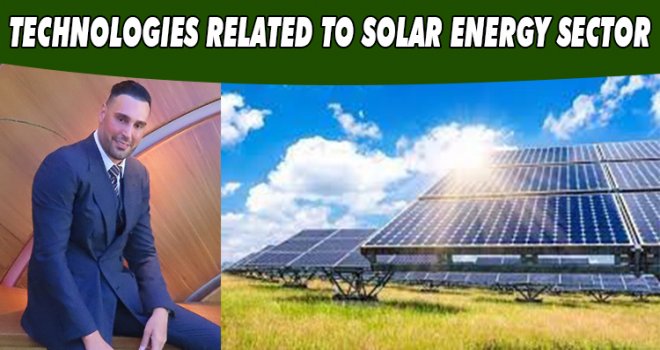TECHNOLOGIES RELATED TO SOLAR ENERGY SECTOR

Today, the importance of solar energy systems has increased and become popular. Solar energy is mainly used for two purposes: electricity generation (photovoltaic solar energy or thermodynamic solar energy) or heat generation (solar thermal energy).
Photovoltaic solar energy converts solar radiation into electricity using photovoltaic cells integrated into panels that can be installed in buildings or placed on the ground, while thermodynamic solar energy generates electricity through heat generation.
The electricity produced can be used on-site or re-injected into the electricity distribution grid. Solar thermal energy generates heat that can be used for domestic heating or domestic hot water production.

Photovoltaic
Photovoltaic (PV) technologies rely on cells that convert solar radiation into direct current electricity. These cells are interconnected to form a module, which itself is connected to various electrical components. The whole forms a photovoltaic system. The lifetime of a module is about 25 years.
Today, there are different cell technologies at different stages of technological maturity.
Crystalline Silicon (1st generation photovoltaic): Cells consist of thin sheets of silicon, an element extracted from sand or quartz. Depending on the crystallization method used, monocrystalline silicon or polycrystalline silicon is obtained. The lifetime of photovoltaic modules made from these cells is estimated to be between 25 and 30 years.
Thin Layers (2nd generation photovoltaic): These cells are used to make semiconductor and photosensitive materials such as glass, plastic, steel, etc. obtained by placing it on a support.
Different materials can be used. The most common is amorphous silicon. But other materials contain rare chemical elements. This technology makes it possible to reduce production costs. However, the cells have a lower efficiency than in the case of crystalline silicon. It has made significant progress in recent years.
Organic Cells (3rd generation photovoltaics): These modules consist of organic molecules. Solar collectors come in the form of photo-type films that are flexible, lightweight and easy to install. There are currently three types of organic photovoltaic cells: molecular ones, polymer ones and hybrid organic ones.
The potential interest of these technologies is to offer solar power at a significantly lower price than first- and second-generation technologies. However, these are still in the research and development stage.
However, these cells are already used in certain low-consumption and high-value-added applications, such as calculators or charging mobile devices.
Concentrated Cells (technology known as CPV): This technology uses optical lenses that concentrate light on small, high-performance photovoltaic cells.
Their efficiency is higher than the silicon sector. But they should always be positioned facing the sun. This is made possible with a viewer setup. This technology is currently only of economic interest in areas where direct sunlight is crucial.
Hybrid Perovskite Cells: Still in the laboratory development phase, this is a very promising sector that has shown remarkable progress in efficiency in recent years. This process is related to thin film technology and is based on lead methylammonium iodide.
Approximately 22% efficiency was obtained in the laboratory. Research is ongoing to ensure better stability of these cells and to make them more resistant to moisture.

Thermal Energy
Technologies related to this sector aim to convert solar radiation into thermal energy. This equipment makes it possible to directly use the thermal energy of the sun. The heat produced can be used for domestic heating or domestic hot water production.
The 3 most common types of equipment:
- Individual solar water heaters that allow the production of hot water for sanitary use for individuals with an efficiency of approximately 400 to 450 kWh/year/m2 depending on the climate zone.
- There are combined solar energy systems that provide both domestic hot water production and heating for private use. The sensor surface corresponds to approximately 10% of the surface to be heated. The conventional generation adopted for an optimized system is 450 kWh/year/m².
- Collective solar hot water area. Equipment is usually sized to meet 40% to 60% of needs. Equipment for each installation is pre-designed and dimensioned by a design office.
Solar equipment never provides 100% of hot water or heating needs and requires a supplement.
Photovoltaic / Thermal (PV/T) Systems
A new hybrid sector is emerging, combining both solar photovoltaic and solar thermal in buildings. This sector relies on hybrid solar panels that simultaneously generate electricity and useful heat.
A hybrid solar panel uses the heat released by photovoltaic cells to heat a heat transfer fluid. This improves the efficiency of PV cells while recovering useful solar heat for domestic hot water or heating.
In a water-vector hybrid solar panel, the heat transfer fluid is water-based. This process is often used to contribute to domestic hot water (DHW) production.
In an air vector hybrid solar panel, the heat transfer fluid is air. This process is often used to contribute to the heating of buildings.
-
 Küfür ediyor ve siyasi yorumlarıyla tepki çekiyor: Musk'ın sohbet botu Grok nede..
Küfür ediyor ve siyasi yorumlarıyla tepki çekiyor: Musk'ın sohbet botu Grok nede..
-
 YDP, Gençlik Şöleni düzenliyor: Gençler siyasete katılıma teşvik edilecek..
YDP, Gençlik Şöleni düzenliyor: Gençler siyasete katılıma teşvik edilecek..
-
 ABD, Heyet Tahrir Şam'ı terör örgütü listesinden çıkardığını duyurdu
ABD, Heyet Tahrir Şam'ı terör örgütü listesinden çıkardığını duyurdu
-
 ARIKLI: GENÇLERE MADDİ MANEVİ HER TÜRLÜ DESTEK SAĞLANMALI
ARIKLI: GENÇLERE MADDİ MANEVİ HER TÜRLÜ DESTEK SAĞLANMALI
-
 Milli sporcumuz Azra Avcı U14 Türkiye Şampiyonu oldu!
Milli sporcumuz Azra Avcı U14 Türkiye Şampiyonu oldu!
-
 İEZB Başkanı Serkan Kırmızı’dan KIB-TEK’e Sert Tepki: Bu Bir Enerji Beka Sorunud..
İEZB Başkanı Serkan Kırmızı’dan KIB-TEK’e Sert Tepki: Bu Bir Enerji Beka Sorunud..
-
 Othello Folklör Master ekibi Bosna'daydı
Othello Folklör Master ekibi Bosna'daydı






